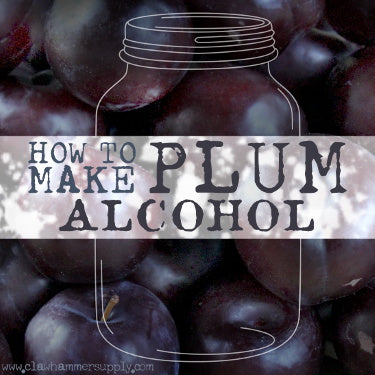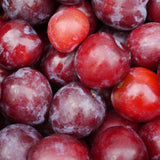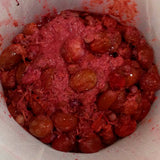This blog provides information for educational purposes only. Read our complete summary for more info.
Plum Brandy

In this guide, we walk you through the entire process of making plum brandy from start to finish. We provide you with step-by-step instructions on recipe creation, fruit preparation, fermenting, distilling, aging, blending, and bottling. To ensure that we provide you with the most accurate tutorial possible on how to make plum brandy, we enlisted the help of a local orchardist and experienced plum brandy distiller.
What is Plum Brandy?
Though, before we dive into the process of making plum brandy, let's answer the question of, "what is plum brandy?" Plum brandy, also known as Slivovitz, is a distilled alcoholic beverage made from fermented plum juice. As far as plum brandy ingredients go, plum brandy is made from nothing more than water, plums, perhaps a bit of extra sugar to increase proof, and yeast. Unlike other fruit brandies, plum brandy has a unique aroma and taste that is difficult to replicate. If you've ever tried plum brandy, you know what we mean. If you haven't, it's a slightly sweet, warm plum taste that may just make for the best type of fruit brandy on planet Earth.
Oh, and it's worth noting that traditionally brandy is made using grapes. Here's a traditional grape brandy recipe. Also, brandy can be made with any type of fruit. For example, here's an explanation of how to make apple brandy.
Where is Plum Brandy Made?
It is a traditional drink that is popular in many countries. However, it's especially popular in Eastern Europe. First, plums are widely grown in this region. Second, there is a long tradition of plum brandy production in this area of the world and in some places such as Hungary, it's legal to make at home. In I (Kyle, the author of this article) was fortunate enough to visit Hungary in the summer of 2006 and had an opportunity to taste Pálinka, homemade brandy distilled from plum juice. It was quite an experience (I think!). Homemade brandy isn't exactly a memory booster, if you know what I mean.
Is it Legal to Make Brandy at Home?
The production of plum brandy is a highly regulated process, and it varies from country to country. In some countries, such as Serbia, Croatia, and (as we mentioned) Hungary, the production of homemade brandy is considered an art form and is a significant part of the cultural heritage. In other countries, such as the United States, the production of any type of distilled spirits, for personal consumption, plum brandy or otherwise, is illegal. The only way to produce this product in the US is by first obtaining federal, state, and local licenses and permits.
How is Plum Brandy Made?
Plum wine is made by picking plums washing them, then crushing and juicing them. The plum juice is then chemically treated or heated to pasteurize it, eliminating natural bacteria and wild yeast. After this is complete, yeast is added to the plum juice and it's allowed to ferment. Once fermentation is finished it's distilled, aged, blended and bottled.
Brandy Making Equipment
Here is the equipment needed to make plum brandy. This covers fruit processing, fermentation, and distillation.
- Potato masher
- 6.5 gallon fermenter
- Large pot for mashing
- Mash paddle or spoon
- Brewing/Wine hydrometer or refractometer
- Stainless steel still
Plum Brandy Recipe
Here's the recipe that was used to make the plum brandy that was distilled for this article. We'll first start with some benchmarks such as starting gravity and final gravity. These numbers are used to determine the alcohol by volume of the fermented plum juice (or plum wine) prior to distillation.
Plum Brandy Ingredients
- 20-35 pounds of red and yellow Italian plums (enough to get 3 gallons of liquid)
- 5 pounds of red table grapes (slightly over ripe)
- 5 Campden tablets (Potassium Metabisulfite: used to prevent oxidation and growth of wild yeast and bacteria in mash)
- 5 Tablespoons Pectic Enzyme (Add to mash to break down pulp and aid in the extraction of tannin)
- 2 teaspoon Grape Tannin: (In conventional wines it comes from the skin of the grape but most grapes contain very little amount of tannin)
- 2.5 teaspoon yeast nutrient (We just Followed the directions on the label we have found that most brands require 1/2 tsp per gallon)
- 4 pounds of cane sugar
- 1 packet dry wine yeast (Lalvin RC-212 Red Wine Yeast)




Plum Brandy Mash Steps
Here are the steps we followed to make plum brandy mash, which is the first part of the process in making plum brandy.
- We washed the fruit
- We added 4 gallons of water to a pot on the stove and brought it up to a boil. We found by the time we were done processing the fruit the water was up to a boil. While the water was coming up to a boil we were doing the steps below.
- We added a few of the plums at a time to a mash pot and smash them with the potato masher. We did not remove the pits or the stems, as we will filtered those out before distilling.
- Once we had 3 gallons of plums/juice collected in the mash pot we stopped adding plums.
- We then added 5 pounds of smashed grapes to the mash pot.
- We then removed the 4 gallons of water from the stove and add enough water to reach 5.5 gallons of total volume of liquid in the mash pot.
- We then stirred the mash extremely well. We made sure the boiling water was well mixed into the mash.
- We then transferred the mash into a 6.5 gallon fermenter
- We added 5 campden tables to the fermenter and covered with a cheesecloth for 24 hours. Stir the mash periodically as the campden tablets will kill any wild yeast/bacteria in the mash.
- After the 24 hour rest we added 5 Tablespoons of Pectic Enzymes. Plums have a very high pectin rate and the enzyme helped breakdown the pectin in the fruit.
- We then added 2 teaspoons of Grape Tannin - we did not need to add much as we already added the skins, pits, and stems from the fruits into the mash .
- We also added 2.5 teaspoon yeast nutrient. We just followed the directions on the label.
- We then added 4 pounds of cane sugar to the 6.5 gallon fermenting bucket and mixed well.
- We then took a starting gravity reading and it was 1.07
Plum Brandy Fermentation Steps
After brandy mash making process was complete we proceeded to ferment the plum juice in order to make plum wine. This is an important part of the process because it is during the fermentation process that alcohol is created.- We add 1 packet of Lalvin RC-212 red wine yeast to the fermenter.
- We added an airlock to the fermenter and fermented in a dark room at 68 degrees. The entire fermentation process took about 2 weeks.
- After fermentation, we transferred the wash to a 5 gallon bucket lined with a nylon strainer. This allowed us to strain any solids from liquid. We always make sure to only transfer liquid to the still.
- We then took a final gravity reading. It fermented down 1.000 which yielded 9.19% ABV
Plum Brandy Distillation Steps
Note, we had a fuel alcohol permit when we tested this procedure and we were in compliance with state and federal regulations. We produced, stored, and used this alcohol in accordance with TTB requirements, which unfortunately means that we weren't able to drink it. We also kept and reported production logs in accordance with TTB fuel alcohol permit requirements.
- Because plums have a very high pectin content, a commerical distillery making plum brandy for consumption would most likely discard double the amount of fore shots (the first runnings from a still): probably 300ml for a 5 gallon batch. Because we were making fuel alcohol, in accordance with the permits we possessed at the time, we separated this but kept it for fuel.
- A commercial distiller would also make tight heads and tails cuts. Since we were making fuel alcohol this did not apply to us. However, what this means is that they would set aside about the first 30% of the liquid produced by the still (called the heads), they would keep the middle 30(ish)% (called the hearts), and they would also set aside the last 30(ish)% of the distillate (called the tails). The hearts would be aged, blended, and bottled. The heads and tails would be combined and added to the next distillation run.
- Aging the product in a barrel typically takes commercial producers several months to several years, depending on the aging method and the desired taste, strength, and quality of the final product.




Is it safe to distill with flesh and seeds intact
I am getting that blue tint of copper sulfate out of the still. It has a copper coil. Anyone can help me with that ?
I was distilling plum mash.
Very interestedd
other than the fruit, where can I purchase the other ingredients for your Plum moonshine, the gravity stick and ingredients for Brandy?
Hi fellow shiners
I make Apple Pie shine;Cherry Pie;Cranberry;Lemon Drop;Strawberry; an peppermint.
Can you help me. I have 120 lbs of canned peaches and want to make a 30 gal mash of peach. What extras should I add and how many pounds do I need to add for a 30 gal mash